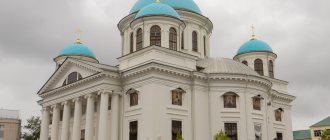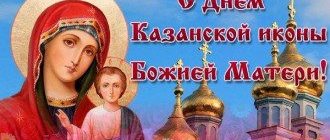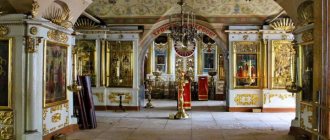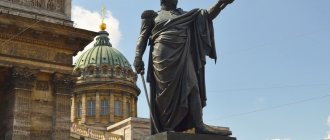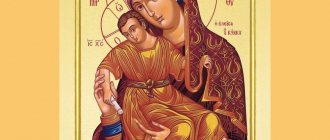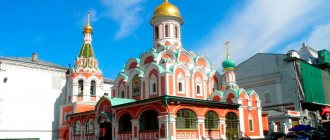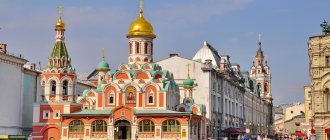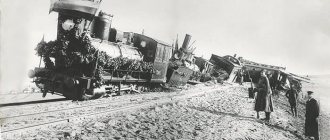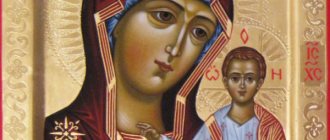In the summer of 1579, a terrible fire destroyed most of Kazan. Two weeks later, the Mother of God appeared in a dream to a girl named Matrona Onuchina, who ordered her icon to be dug up from the ashes. In the indicated place, at a depth of about a meter, an icon was actually found. Before the Battle of Poltava in 1709, Russian Tsar Peter I and his army prayed in front of the Kazan Icon of the Mother of God; later one of the copies of the miraculous icon was transferred to St. Petersburg. Since 1737, this icon was in the Church of the Nativity of the Virgin Mary on Nevsky Prospect; in 1811, the icon was placed in the new Kazan Cathedral. The Kazan Icon became one of the main Orthodox shrines of St. Petersburg.
Prayer to the Kazan Icon of the Mother of God:
Oh, Most Holy Lady, Lady Theotokos! With fear, faith and love, falling down before Your honest and miraculous icon, we pray to You: do not turn Your face away from those who come running to You. Deliver all those who pray to You with faith from the falls of sin, from the slander of evil people, from all temptations, sorrows, illnesses, troubles and sudden death. Grant us the spirit of contrition, humility of heart, purity of thoughts, correction of sinful life and remission of sins, so that all who gratefully sing of Thy greatness and mercy, manifested over us here on earth, may be worthy of the Kingdom of Heaven, and there with all the saints we will glorify the most honorable and magnificent name of the Father and the Son and the Holy Spirit forever and ever.
The Kazan Cathedral in St. Petersburg is an Orthodox cathedral church located in the very center of the city. The facades of the temple overlook Nevsky Prospekt and the Griboyedov Canal. This is one of the largest buildings in the Northern capital. Its height reaches 71.5 meters. An island in the Neva delta, a bridge at the intersection of Nevsky Prospekt and the Griboyedov Canal, and a street that runs off the temple are named after him.
How to get there
The Kazan Cathedral is located in the center of Moscow on Nikolskaya Street. Getting to it is not difficult - several metro stations and public transport stops are within walking distance from the shrine. You can also take a taxi or go by car.
Metro
The metro is perhaps the most convenient transport in the capital. From the station closest to the cathedral, “Okhotny Ryad” (red line), walk only about 100 meters from exit No. 7. In addition, the Teatralnaya station (green line) is nearby, and a little further “Revolution Square” (blue line).
Moscow metro map - Yandex. Metro
View of the cathedral from Nikolskaya street:
Public transport
300 meters away, near the Okhotny Ryad metro station, there are stops: Okhotny Ryad Metro and Manezhnaya Ploshchad. Buses and minibuses run here: No. M2 (to Rizhsky Station), M3, M10, M27, H1 (night to Sheremetyevo Airport), H2 (night), H11 (night to Vnukovo Airport), H12, 101, 144 , 904.
A little further (on the opposite side of Red Square, near St. Basil's Cathedral) there is another bus stop - “Red Square”. Buses No. M5 and 158 depart from it.
Moscow public transport portal
History of the Kazan Cathedral in St. Petersburg
In 1710, a chapel was built on Nevsky Prospekt next to the wooden hospital building, and later the wooden Church of the Kazan Mother of God. By decree of Empress Anna Ioannovna, the new stone church was founded in September 1733, built according to the design of M. Zemtsov and was named Rodestvensky. A significant decoration of the built church was a multi-tiered bell tower 58 meters high.
On July 2, the Kazan Icon of the Mother of God was transferred here from the Trinity Cathedral. And the Nativity Church began to be called Kazan Church after the name of this icon. Later, the church received the status of a Cathedral, which became the main temple in the Northern capital.
By the end of the 18th century, the building had fallen into disrepair and a decision was made to build a new temple. Paul I wanted the new temple to be similar to St. Peter's Cathedral in Rome and in 1799 a competition was announced for its design.
Count A.S. Stroganov, whose residence was located near the temple, proposed a project by the young architect A.N. Voronikhin, his former serf. The project of Andrei Nikiforovich Voronikhin was approved. In the presence of Alexander I, a new temple was founded. Count Stroganov became responsible for the construction, which was completed by 1811. And the author of the project A.N. Voronikhin was awarded the Order of Anna, second degree, and a lifelong pension.
Only Russian craftsmen participated in the construction of the temple. The team of masons was led by Samson Sukhanov. Most of the builders were serfs, who gave all their earnings to their owners. They lived first in dugouts outside the city, and then in barracks on Konyushennaya Square. Domestic materials were used to decorate the temple: Olonets marble, Vyborg and Serdobol granite, Riga limestone. The external cladding of the walls is made of Pudozh stone, which was brought from Gatchina.
Mysterious old lady
Several years ago, during a patronal feast day in an Old Believer church in Kazan, after a service, procession and festive meal, a modest old woman approached one of the visiting foreign bishops. She held out a postcard on which the Kazan Icon of the Mother of God was depicted, and joyfully said:
—Have you never been to Kazan before and seen the real revealed Kazan Icon? Let's go! I know where she is now! I'll show it to you!
Either Vladyka did not understand well, or he was in a hurry to attend to other matters, but he smiled politely and walked past. The old woman moved sadly along the fence near the temple and placed a postcard with the image on the chipped bricks. People quickly dispersed. The wonderful face on the small postcard smiled faintly.
Colonnade of the Kazan Cathedral in St. Petersburg
A.N. Voronikhin solved the main problem. Since there should be an entrance in the west of the temple and an altar in the east, the temple turned out to be sideways to Nevsky Prospekt. According to the architect's decision, a grandiose colonnade of 96 columns 13 meters high, made in the form of a semicircle, was erected in front of the northern facade. And the northern part of the temple, facing Nevsky Prospect, became the front door, decorating the main thoroughfare of the city - Nevsky Prospekt. The temple project was not fully realized. According to the plan, the colonnade should have been on both sides: on the south and on the north. But only the northern colonnade was built. In front of the western, main entrance to the cathedral, the side porticoes of both colonnades were to be connected by a fence surrounding the square.
Decoration of the Kazan Cathedral in St. Petersburg
At the northern facade of the temple you can see four bronze sculptures: Prince Vladimir (sculptor S. Pimenov), Andrew the First-Called (V.I. Demut-Malinovsky), John the Baptist (I.P. Martos) and Alexander Nevsky (S. Pimenov). The bronze entrance doors on the north side of the building are a copy of the doors of the baptismal house in Florence. They were cast and minted by Vasily Ekimov. The architect's plans for the external sculptural design were also not fully realized. On stone pedestals on both sides of the colonnade there were supposed to be sculptures of the archangels Michael and Gabriel.
The interior of the temple resembles a huge palace hall. Rows of tall granite columns unite the space of the hall. The light pouring from the windows gives the impression that the dome is floating at a great height.
The icons for the temple were painted by V. Borovikovsky, O. Kiprensky, A. Ivanov and other famous artists. In 1899–1900, a park was built in front of the temple.
Prayers
Troparion, tone 4
O zealous intercessor,/ Mother of the Lord Most High,/ pray for all Thy Son Christ our God,/ and let all be saved, into Thy sovereign protection of those who flee./ Intercede for us all, O Lady ́ Queen and Lady, / like in adversity and sorrowful, and in illness, burdened with many sins, / standing and praying to You with a tender soul and a contrite heart, / before Your most pure image with tears, / and irrevocably I give them hope those who are on You, deliverance from all evils, / grant usefulness to everyone and save everything, Mother of God Virgin :// For You are the Divine protection of Your servant.
Kontakion, tone 8
(Similar to: Taken:)
Let us come, people, to this quiet and good haven,/ to the quick Helper, ready and warm salvation, the protection of the Virgin,/ let us hasten to prayer and strive for repentance:/ for it exudes sorrow to us The blessed mercy of the Most Pure Mother of God, / advances to help and delivers from great troubles and angry// His well-behaved and God-fearing servants.
Greatness
We magnify Thee,/ Most Holy Virgin,/ and honor Thy holy image,/ from which flows gracious help// to all who flow to it with faith.
Monuments to M.B. Barclay de Tolly and M.I. Kutuzov at the Kazan Cathedral in St. Petersburg
All important events in the history of Russia were connected with the temple. From here, after a solemn prayer service, Field Marshal M.I. left for the active army. Kutuzov. And here in June 1813 the ashes of the great commander were delivered. Kutuzov's body was buried in a crypt built in the northern aisle of the temple. Captured banners and keys to cities that surrendered to the Russian army were placed nearby.
Monuments to M.I. Kutuzov and M.B. Barclay de Tolly organically fit into the architectural and sculptural ensemble of the temple. The figures of the commanders were cast from bronze according to the models of the sculptor B.I. Orlovsky. The monuments are identical: the commanders are depicted at full height, with cloaks thrown over their shoulders. But if the figure of Barclay is depicted waiting, then Kutuzov seems to be giving a signal to his troops to attack.
Intercession of the Queen of Heaven for the Russian land
The Kazan Icon of the Mother of God is an unshakable reminder of the mercy of the Mother of God to the Russian land. But this is also evidence of Her intercession for our country in the most difficult years for Russia.
Kazan Bogoroditsky Monastery, Kazan
The beginning of the history of the Kazan Icon of the Mother of God
In 1552, Tsar John Vasilyevich ordered the foundation of a cathedral in the name of the Annunciation of the Blessed Virgin Mary. This happened the day after the capture of Kazan by the army of the Moscow monarch. And a year later they established the Kazan diocese and sent the first Kazan bishop, Saint Gurias. But more than a quarter of a century later, in 1579, a terrible fire engulfed the city. The fire devastated not only half of the Kazan Kremlin, but also part of the city buildings adjacent to it. And the Mohammedans spoke. Firstly, as if the Russian God is unmerciful to people. Secondly, He showed His anger against them by fire. “The Faith of Christ,” the chronicler noted, “has become a byword and a reproach.” It was then that the Lord showed His mercy.
The icon was found in the ashes
The Mother of God appeared in a dream to a 9-year-old girl, the Streltsy daughter Matryona. The Mother of God ordered us to look for Her icon in the ashes of the burnt house. They didn’t believe the girl for a long time. Her mother walked around the city authorities for a long time and fruitlessly. But on July 8 (old style), Matryona’s mother herself took a spade and found an icon in the place indicated by the Queen of Heaven. The miraculous image was wrapped in an old sleeve of men's clothing made of cherry cloth. Moreover, the Face of the Most Pure One was bright and clear, as if the icon had just been painted.
Kazan Icon of the Mother of God. The prototype is lost
The image was solemnly transferred to the parish church of St. Nicholas of Tula. The rector of which was then a pious priest, the future Patriarch Hermogenes. His Holiness died at the hands of the Poles for his loyalty to Orthodoxy and was canonized. The future saint compiled a detailed account of the miracles of the Kazan Icon of the Mother of God.
Monarchs favor the Kazan icon
Tsar Ivan the Terrible ordered to build a convent for forty nuns at the site where the icon was found; the young woman Matryona and her mother were the first to take monastic vows in the new monastery. In 1594, the extensive Kazan Cathedral was founded here. Abundant contributions of utensils, images, and vestments were made to the monastery; The miraculous was surrounded by royal gifts - gold, precious stones, pearls. Two centuries later, Empress Catherine II presented Kazan with a new chasuble. Her main decoration was the diamond crown, which the earthly ruler took off for the sake of the Queen of Heaven. In 1798, a new extensive cathedral was laid for Kazan, and in 1808 it was consecrated. Unfortunately, it was destroyed along with the entire Bogoroditsky Monastery already in the 1930s. But by that time the icon was no longer here.
By Divine Providence, the appearance of the Kazan Icon under Tsar Ivan Vasilyevich marked the beginning of Russia’s centuries-long advance to the east. Through the window to Asia opened by the capture of Kazan, Orthodoxy walked along with the people. Firstly, it enlightened the whole of Siberia. Secondly, it reached, together with the Russian state, the shores of the Pacific Ocean. It was as if this entire movement had a special blessing from the Most Pure One through Her Kazan Icon.
Theft of the Kazan Icon
On the night of June 29, 1904, several sacrilege-robbers, led by a certain V.A. Stoyan-Chaikin, climbed into the cathedral, attracted by the precious decorations of the chasuble. When the blasphemers were caught, neither the robe nor the miraculous image itself was with them anymore. The main robber assured more than once that they sawed the robe and sold it to jewelers. But they threw the icon into the oven to check whether it really was miraculous. It happened in the house of the merchant Shevlyagin in the Academicheskaya Slobodka of Kazan. A long-term investigation and comparison of the contradictory testimonies of the sacrileges did not lead to anything.
Catholics buy the Kazan icon
They said that the icon was actually bought by Shevlyagin. After the revolution, he went to England and sold it there into private hands. In the 1960s, the Kazan icon in a precious robe actually appeared in the West. This image turned out to be a masterfully executed copy already in the 20th century. But the robe on him, judging by all the evidence, is genuine. The same one that was on the miraculous icon that disappeared in 1904.
Orthodox Americans tried to buy this image. For this purpose, he even exhibited for a prayer service in a Boston Orthodox church. Thousands of people saw him there. But unfortunately it was not possible to raise funds. As a result, this Kazan, along with the chasuble decorating it, was bought by Catholics in 1970. The Kazan Icon of the Mother of God was kept for a long time in the Portuguese city of Fatima, and since 1982 it has been in the Vatican.
But if this is so, if the original chasuble was not sawn apart, then the first miraculous image of Kazan could have been preserved. This is what thousands of Orthodox people believed and continue to believe. Who knows what Chaikin was thinking as he slowly faded away in solitary confinement in Shlisselburg for many years. What did he lie about and what did he tell the truth about? It is difficult to imagine a crime more terrible than the burning of an image in an oven. After all, for centuries, myriads of pilgrims have flocked to him, the most ardent prayers of all Russia have been addressed to him...
